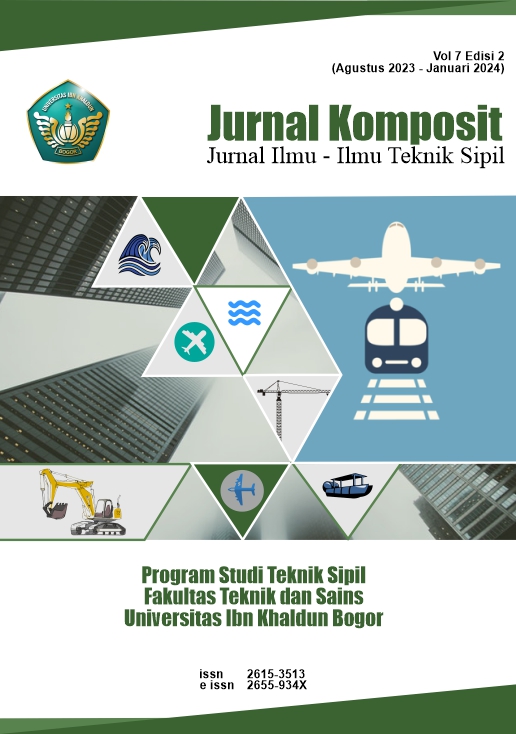Kajian Tampungan Kapasitas Hulu Bendung Karet Tirtonadi pada Penanganan Banjir Kota Surakarta Paket – 3
DOI:
https://doi.org/10.32832/komposit.v7i2.14248Kata Kunci:
Debit banjir, HSS Nakayasu, Kapasitas Sungai, Kapasitas Tampungan, Bendung KaretAbstrak
ABSTRAK: Musim penghujan debit air sungai/kali sering mengalami peningkatan kapasitas volume air yang berasal dari intensitas air hujan. Hal ini yang sering membawa dampak kerusakan kanan dan kiri aliran sungai/kali dan penumpukan sedimen pada beberapa lokasi yang dilewatinya. Kajian dilakukan untuk mengetahui kapasitas tampungan hulu bendung karet tirtonadi setelah pelaksanaan pada penanganan banjir kota Surakarta Paket – 3 berdasarkan parameter penilaian kondisi fisik dan simulasi dengan software HEC-RAS 5.0.3. Pengumpulan data data primer dengan meminta gambar hasil kerja atau as built drawing untuk long section dan cross section secara langsung kepada kontraktor sedangkan untuk memperoleh data sekunder tentang kondisi sungai, curah hujan, tinggi muka air dan data AWLR Sungai Bengawan Solo diperoleh dari data dari BBWS Bengawan Solo serta data dari BPSDA Bengawan Solo. Metode perhitungan debit rancangan menggunakan metode HSS Nakayasu. Dan hasil perhitungan Q50 dalam hasil simulasi yang dilakukan dengan HEC-RAS 5.0.3. Hasil analisis menunjukkan debit banjir maksimal Kali Pepe yang diperoleh dari curah hujan pada tanggal 15 Desember 2020 diketahui debit kapasitas sungai kali pepe Q50th sebesar 998.39 m3/dt. Penambahan kapasitas sungai kali pepe hulu 673.39 m3/dt dari kapasitas sungai kali pepe hulu lama 325 m3/dt. Dan kapasitas tampungan setelah pelaksanaan penanganan banjir kota Surakarta paket-3 diperoleh volume sebesar 710.870 m3.
Kata Kunci : Debit banjir, HSS Nakayasu, HEC-RAS, Kali Pepe, Analisis, Kapasitas sungai, kapasitas tampungan.
Referensi
Kurniawan, A. (2012). Simulasi Profil Muka Air pada Bendung Karang Menggunakan Program Hec-Ras 4.1.0. Vocational undergraduate thesis, UNY. http://eprints.uny.ac.id/id/eprint/1969
Direktorat Jendral Cipta Karya. (2012). Tata Cara Perencanaan Kolam Detensi, Kolam Retensi dan Sistem Polder. Buku Jilid IA, Tata Cara Penyusunan Rencana Induk Sistem Drainase Perkotaan (hal.108-146). Jakarta: Kementerian Pekerjaan Umum
Wibowo, H. (2001). Kajian Geometri Sungai terhadap Kapasitas Angkutan Sedimen dan Debit Aliran (Studi Kasus Sungai Citanduy di Jawa Barat), Thesis, Program Pascasarjana Institut Teknologi Bandung.
Istiarto, I. (2014). Simulasi Aliran 1-Dimensi Dengan Bantuan Paket Program Hidrodinamika HEC-RAS Jenjang Dasar: Simple Geometry, Universitas Gadjah Mada.
Prayoga, M. D., Agami, R. T. W., Sangkawati, S., & Sugiyanto, S. (2013) Perencanaan Kolam Retensi dan Stasiun Pompa pada Sistem Drainase Kali Semarang. Jurnal Karya Teknik Sipil, 2(2), 209-218.
Jailani., M. (2005). Kajian Debit Banjir Sungai Way Laay (Ungauge Watershed) Kecamatan Karya Penggawa Kabupaten Lampung Barat, Thesis. Program Magister Profesional PSDA Institut Teknologi Bandung.
Utami, T., Purwadi, O. T., & Susilo, G. E. (2016). Desain Penampang Sungai Way Besai Melalui Peningkatan Kapasitas Sungai Menggunakan Software HEC-RAS. Jurnal Rekayasa Sipil dan Desain, 4(2), 185-196.
Sri Harto, Br. (1993), Analisis Hidrologi, Jakarta: Gramedia Pustaka Utama.
Sosrodarsono, S. & Takeda, K. (1987). Hidrologi Untuk Pengairan. Jakarta: Pradayana Paramita.
Soewarno. S. (1995). Hidrologi Untuk Teknik. Bandung: Penerbit Nova.
Soedibyo (1993). Teknik Bendungan. PT. Pradnya Paramita. Jakarta.
Triatmodjo, B. (2008). Hidrologi Terapan, Yogyakarta: Beta Offset.
Linsley, R. K. (1989). Teknik Sumber Daya Air. Jakarta: Erlangga.
Prakasa, R. J., Anggoro, R., Kadir, A., & Falah, A. (2013). Analisis Kapasitas Penampang Banjir Kanal Barat Kota Semarang Untuk Perencanaan Pengendalian Banjir. Jurnal Karya Teknik Sipil, 2(1), 290-308.
Baskoro, W. A. (2009). Pengaruh Pembangunan Jetty di Muara Sungai Way Kuripan. Kota Bandar Lampung. Thesis, Program Pasca Sarjana Universitas Diponegoro. http://eprints.undip.ac.id/17791/
Unduhan
Diterbitkan
Cara Mengutip
Terbitan
Bagian
Lisensi
Hak Cipta (c) 2023 Jurnal Komposit: Jurnal Ilmu-ilmu Teknik Sipil

Artikel ini berlisensiCreative Commons Attribution-ShareAlike 4.0 International License.
Authors who publish with this journal agree to the following terms (Penulis yang mengajukan publikasi artikel telah menyetujui hal berikut):
- Through this publication, the author agree to submit the copyright of article writing to Jurnal Komposit: Jurnal Ilmu-ilmu Teknik Sipil. This copyright submission takes the form of, but is not limited to: reproduction of the article and parts therein, including photographic reproductions; distribution of articles through printed and electronic documents; and translation of articles(Bahwa melalui publikasi ini, hak cipta penulisan artikel diserahkan kepada Jurnal Komposit: Jurnal Ilmu-ilmu Teknik Sipil. Penyerahan hak cipta ini berupa, namun tidak terbatas pada: perbanyakan artikel dan bagian di dalamnya, termasuk reproduksi fotografi; penyebarluasan artikel melalui dokumen cetak dan elektronik; serta penterjemahan artikel).
- The authors agree to the terms of the Copyright Notice, according to Creative Commons Attribution-NonCommercial-ShareAlike 4.0 International License., which will apply to this article if and when it is published by Jurnal Komposit: Jurnal Ilmu-ilmu Teknik Sipil. (Para penulis setuju dengan ketentuan Pemberitahuan Hak Cipta, sesuai dengan Lisensi Internasional Creative Commons Attribution-NonCommercial-ShareAlike 4.0., yang akan berlaku untuk artikel ini jika dan ketika diterbitkan oleh Jurnal Komposit: Jurnal Ilmu-ilmu Teknik Sipil).

This work is licensed under a Creative Commons Attribution-NonCommercial-ShareAlike 4.0 International License.



.png)










